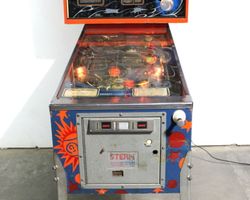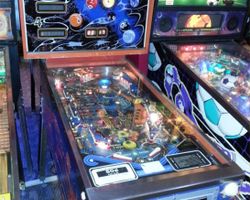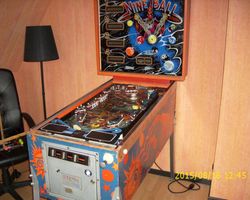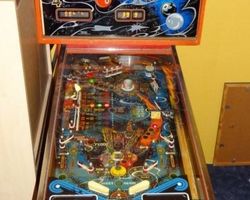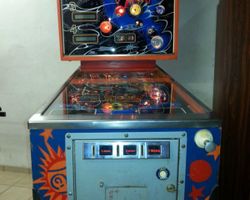Nine Ball
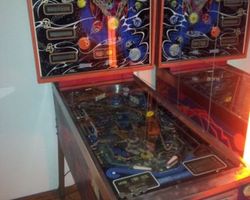
Average Prices: Not enough auctions
Produced: December, 1980
Production Run: 2,279 units
Machine Type: Solid State Electronic
MPU: Stern M-200 MPU
Players: 4
Concept by: Steve Kirk
Design by: Steve Kirk
Art by: Robert Quinn, Jorge Obregon
Dots/Animation by: Jorge Obregon
Software by: Rob Quinn
Stern Electronics, Inc. released Nine Ball in December 1980, a solid-state pinball machine that merged the classic game of billiards with a fantastical space-wizard theme. This unique blend positioned Nine Ball as a distinctive offering during a pivotal time for pinball, as manufacturers transitioned from electromechanical designs to the possibilities of electronic systems. The machine was conceived by Steve Kirk, a designer known for his thoughtful playfield layouts and contributions to the pinball community, including founding the Pinball Association of America. Kirk's vision for Nine Ball extended beyond the playfield, influencing tournament play with features like the "Kirk Post" and "Tournament Pinball" designations. The striking visual identity of Nine Ball stemmed from the collaborative efforts of artists Jorge Obregon and Robert Quinn, with Obregon also handling animation. The wizard design, a central motif on both the backglass and playfield, drew inspiration from an unexpected source: a T-shirt.
Production of Nine Ball spanned from December 1980 to April 1981, with 2,279 units manufactured. Despite its inventive design, the machine encountered challenges with its early solid-state software, characteristic of some Stern titles from that period. Numerous revisions were made to the game's ROMs in an effort to stabilize performance on location, with version U6 eventually proving to be the most reliable. This persistent effort highlights the growing pains of a rapidly evolving technology and the dedication to refining the gameplay experience. Steve Kirk left a personal mark on his designs, often including an "SK" (Steve Kirk) and a number on the artwork, with "SK-3" subtly visible on the wizard's cap on Nine Ball's backglass. This small detail, along with the "selected for tournament play" stickers found on aprons, underscores Kirk's direct involvement and passion for competitive pinball.
Signature Features and Design
Nine Ball stands out with several core features that define its challenging and rewarding gameplay. Chief among these is the unique "hanging spinner" target, strategically placed so that a skillful shot can send the ball ricocheting into it repeatedly from the playfield rubbers. This spinner is not merely a high-score opportunity; a precise plunger skill shot, striking a specific white target directly under a rebound rubber, significantly multiplies its value to 2,500 points per spin, creating a compelling risk-reward scenario from the very launch.
Another prominent feature is the sheer abundance of drop targets, with a total of fifteen spread across the playfield in various configurations: two sets of four-bank targets, two sets of three-bank targets, and a solitary drop target. These targets are not just obstacles but integral components of the game's scoring and progression, often requiring precise direct shots or clever bank shots off other features. The game also incorporates a horseshoe lane, demanding accurate aiming for consistent returns, and a kick-out hole that collects balls for specific modes or multiball activation.
The "Kirk Post," a mini-post screw positioned between the flippers, adds another layer of challenge. While seemingly minor, its placement can dramatically alter ball trajectory, demanding constant awareness and precise flipper control from the player. This element, named after designer Steve Kirk, embodies the game's overall design philosophy of creating a demanding yet ultimately satisfying play experience. The game also features three-ball multiball, a complex objective for its era, which provides bursts of high-scoring action and intense ball control.
Visually, Nine Ball embraces a vibrant, almost psychedelic 1980s aesthetic. The "space crackle" art style, characterized by its cosmic backdrops and stylized elements, is evident throughout. The dominant blue and orange color scheme creates a striking contrast, drawing the eye across the playfield and backglass. The central figure of the "Nine Ball Wizard," a powerful, mystical entity, ties the pool and space themes together, appearing prominently in the artwork to guide the player through the cosmic billiards challenge.
Playfield and Mechanics
The playfield of Nine Ball presents a deceptively open yet strategically dense layout. It features a wide-open central area, providing ample space for ball movement, but it is also precisely populated with numerous targets and objectives that demand accuracy. The two flippers at the bottom control the flow, working in concert with the "Kirk Post" to manage rebounds and saves.
Dominating the lower half of the playfield are the numerous drop target banks. Two four-bank drop targets are placed on either side, often requiring a direct shot from the flippers or a skilled rebound. Higher up, two three-bank drop targets flank a central pathway, challenging players to clear them sequentially or with a single, powerful shot. A solitary drop target, often related to specific scoring objectives, provides a singular focus point. The design philosophy behind this abundance of drop targets encourages a "shooter's game" approach, where precision and shot repetition are paramount. Players are often rewarded for clearing banks, which can light features or advance game progression.
The single pop bumper, while seemingly understated, is strategically placed to interact with balls exiting the upper playfield or those bounced from the horseshoe lane, providing valuable points and chaotic rebound action that can set up subsequent shots. The horseshoe lane itself is a high-risk, high-reward shot, weaving its way through the upper playfield to reward players for accurate aiming. A kick-out hole and a rollunder lane are integrated to collect balls, typically for triggering modes, advancing toward multiball, or awarding bonuses.
The artwork on the playfield, mirroring the backglass, is characterized by its vivid color palette and dynamic lines. Cosmic elements intertwine with billiard cues and balls, creating an atmosphere of a mystical pool hall in space. Lighting is used effectively to highlight active targets and pathways, guiding the player's focus without overwhelming the visual clarity. The overall aesthetic contributes to player immersion, drawing them into the otherworldly realm of the Nine Ball Wizard.
Gameplay Dynamics
Nine Ball's gameplay dynamics are built around challenging players with precise shots and strategic progression. It is unequivocally a "shooter's game," demanding consistent accuracy and control. The primary objectives revolve around clearing the numerous drop target banks, activating the spinner for high scores, and ultimately achieving the coveted three-ball multiball. The strategic depth comes from understanding how to maximize points from each feature, often requiring an analysis of risk versus reward. For instance, hitting the skill shot to supercharge the spinner provides a significant scoring opportunity, but it demands a soft, precise plunge.
Progression in Nine Ball is often tied to sequences and accumulating hits on specific targets. Clearing drop target banks, for example, might light kick-out holes or increase the value of other shots. The game features timed objectives and challenges, pushing players to make quick, decisive shots. Multiball is difficult to achieve, requiring a sequence of precise shots to lock balls. However, once engaged, it transforms the game into a high-energy scramble for points, often described as thrilling despite not always offering overt playfield multipliers. A notable aspect of Nine Ball's multiball is its "stealable" nature in multiplayer games, adding a competitive edge where one player can seize multiball from an opponent by completing a specific objective.
Player strategies often involve prioritizing drop target banks to light features, then focusing on the spinning target for score accumulation. Bank shots off the playfield rubbers or other targets are crucial for hitting otherwise difficult-to-reach drop targets or for sending the ball repeatedly into the hanging spinner. The single pop bumper, despite its solitary presence, is instrumental in setting up chaotic but often advantageous rebounds that can open up new shot opportunities. The game's fast ball speed for its era contributes to its addictive quality, constantly pushing players to react quickly and precisely.
Reception and Legacy
Nine Ball elicits a generally positive reception within the pinball community, particularly among players who appreciate a demanding and skillful experience. Its strengths are frequently cited as its challenging and rewarding gameplay, earning it the moniker of a "shooter's game." Many find it "brutal," "punishing," and "unforgiving," yet these very qualities contribute to its allure for those seeking a true test of their pinball abilities.
The unique features of Nine Ball are a major highlight. The "hanging spinner" is consistently praised, often hailed as one of the most creatively placed spinners in pinball history due to its interaction with playfield rubbers. The sheer number of drop targets (15 in total) and the varied ways they can be hit (directly, via rebounds, or in sequence) provide a rich layer of strategic depth. While difficult to initiate, the three-ball multiball is generally seen as an exciting element, with the "stealable" multiball feature being a particularly appreciated competitive dynamic. Reviewers also frequently commend the game's vibrant 1980s "space crackle" artwork, with the blue and orange color scheme and the "Nine Ball Wizard" figure drawing consistent praise. For an early solid-state machine, many note its surprisingly fast pace, contributing to its "one more game" appeal.
However, Nine Ball is not without its criticisms. The most common point of contention is the perceived opacity of its rules, with some players reporting difficulty in fully grasping the game's objectives and how to progress. The sound package is another frequent target, often described as repetitive or "annoying" by some. While most appreciate the artwork, a minority find the playfield sparse or the backglass less compelling. A few players also found the multiball implementation underwhelming or the shot to lock balls frustratingly difficult.
Despite these criticisms, Nine Ball maintains a strong reputation as an underrated or "hidden gem" in the pantheon of early solid-state pinball machines. Its demanding playfield layout and unique features solidified Steve Kirk's reputation as a designer capable of creating challenging and strategic games. The machine stands as an important example of Stern Electronics' early solid-state era, showcasing the innovative steps manufacturers were taking in design and programming, even amidst technological growing pains. Its focus on precise shooting, intricate drop target play, and a demanding multiball objective has ensured its continued appeal to players who value skill and depth above all else.
Sponsored Links
 Ebay Listings
Ebay Listings
 Auction Results
Auction Results
| Cost | Location | Date |
|---|---|---|
| USD $4,850 |  Florida, United States Florida, United States |
03 June, 2025 |
| USD $2,000 |  Maryland, United States Maryland, United States |
12 December, 2024 |
| USD $4,500 |  Florida, United States Florida, United States |
18 July, 2022 |
| USD $4,500 |  Kansas, United States Kansas, United States |
22 June, 2022 |
| USD $4,900 |  Texas, United States Texas, United States |
30 March, 2022 |
| USD $6,000 |  New Jersey, United States New Jersey, United States |
25 March, 2022 |
| USD $8,750 |  Texas, United States Texas, United States |
21 November, 2021 |
| USD $9,750 |  Ohio, United States Ohio, United States |
30 October, 2021 |
| USD $1,995 |  Texas, United States Texas, United States |
23 April, 2017 |
| USD $1,000 |  Arizona, United States Arizona, United States |
23 January, 2017 |


Private Policy · Search Website · Contact Us
As an eBay Partner, we may earn a commission from qualifying purchases made through links on this site, at no additional cost to you.
All trademarks and copyrighted materials remain property of their respective owners. All other content copyright 2007 - 2025 Pinpedia.

